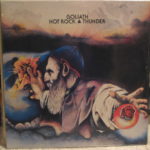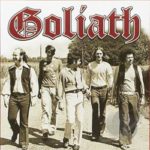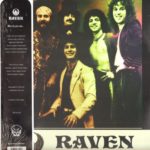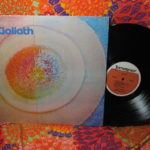Goliath: Unraveling Their History
Goliath – Hot Rock and Thunder (Bridges, 1975; Tomorrow, 1977)
Raven – Who Do You See…(Golden Pavilion, 2013)
 Goliath was founded in Terre Haute in 1969 by members of three garage bands: Sons of Sound, Kicks and the XL’s. The XL’s and Sons of Sound released 45’s. I saw Goliath and the XL’s in concert a few times while attending high school and college in Terre Haute. Goliath existed with several personnel changes throughout the 70’s.
Goliath was founded in Terre Haute in 1969 by members of three garage bands: Sons of Sound, Kicks and the XL’s. The XL’s and Sons of Sound released 45’s. I saw Goliath and the XL’s in concert a few times while attending high school and college in Terre Haute. Goliath existed with several personnel changes throughout the 70’s.
In 1972 they recorded “Hot Rock and Thunder”, though it remained unreleased until 1975. The LP was ultimately issued by Louisville’s Bridges label, label home of another Indiana band, Dawson, and several Kentucky acts. Hot Rock and Thunder features an appealing blend of classic rock with psychedelic and progressive touches.
The original incarnation of Goliath recorded an album in Louisville in 1970. Those sessions remained unreleased until 2009, when rock archivists Gear Fab issued a CD, strangely calling it “The Complete Recordings” despite the obvious existence of Hot Rock and Thunder, none of whose tracks were included. “Complete Recordings” has a rootsier sound, with folk-rock influences that are not present on the later album.
2009, when rock archivists Gear Fab issued a CD, strangely calling it “The Complete Recordings” despite the obvious existence of Hot Rock and Thunder, none of whose tracks were included. “Complete Recordings” has a rootsier sound, with folk-rock influences that are not present on the later album.
Goliath is thought by many to be a Louisville band. Goliath recorded both albums in Louisville and their booking agency, Triangle Talent and label, Bridges, were based there, so that conclusion is warranted, but incorrect. In addition to my recollections of Goliath as a Terre Haute band, there are several discussions on a Terre Haute history Facebook group regarding the band, with input from family, band members, friends and fans that support this. Goliath was definitely a Terre Haute band, though they had one foot in Louisville.
 Raven, was formed in 1972 in Louisville by former Goliath founding members George Egy, George Phelps and Paul (Doug) Mason, along with ex-Micah drummer Robert Wolff and bassist Tim Allen from the ashes of longtime Louisville act The Carnations. This band did establish itself in Louisville and toured across 24 states. Raven recorded in Atlanta in 1976 and secured a record deal from Atlanta-based Capricorn Records, home of The Allman Brothers among others. According to the band, Capricorn filed bankruptcy two weeks later and the band’s contract was voided; subsequently, the master recordings were lost in a fire. Their recollection of timing does not square with historical dates—Capricorn’s official bankruptcy occurred 1979 rather than 1976. There were, however, financial troubles at Capricorn connected to The Allmans’ (Capricorn’s cash cow) initial breakup in 1976 which could have affected Raven’s deal. Regardless, Raven was dealt a lousy hand and eventually disbanded.
Raven, was formed in 1972 in Louisville by former Goliath founding members George Egy, George Phelps and Paul (Doug) Mason, along with ex-Micah drummer Robert Wolff and bassist Tim Allen from the ashes of longtime Louisville act The Carnations. This band did establish itself in Louisville and toured across 24 states. Raven recorded in Atlanta in 1976 and secured a record deal from Atlanta-based Capricorn Records, home of The Allman Brothers among others. According to the band, Capricorn filed bankruptcy two weeks later and the band’s contract was voided; subsequently, the master recordings were lost in a fire. Their recollection of timing does not square with historical dates—Capricorn’s official bankruptcy occurred 1979 rather than 1976. There were, however, financial troubles at Capricorn connected to The Allmans’ (Capricorn’s cash cow) initial breakup in 1976 which could have affected Raven’s deal. Regardless, Raven was dealt a lousy hand and eventually disbanded.
Golden Pavilion, a Portuguese label, afforded the recordings a posthumous release in 2013. Raven’s “Who Do You See…” is powerful, with similarities to the Hot Rock and Thunder record, mining the progressive/arena rock genres and drawing comparisons to Deep Purple, Rush and Yes. According to the members of the band, the surviving tapes were unfinished, lacking a final master mix and mostly recorded live in studio.
Phelps, Egy and Mason were central to the 1970 Goliath recordings, departing before the band recorded again in 1972. They were replaced by Jim Kitchen, Dave Wood and Paul Bays, joining with founding members Bill and Steve Peters prior to the Hot Rock and Thunder sessions. According to Phelps, Kitchen and Joe Adams appeared on one track of the 1970 recordings.
Reportedly financed by John Beeson of the Music Shoppe in Terre Haute, Hot Rock and Thunder was released to some fanfare in Terre Haute, but lacked effective promotion and distribution, as hundreds of unsold copies were tucked away for years in the shop’s storage.
The dead stock was acquired in the early 1990’s by an Indianapolis record dealer and in 1994, at least 100 copies were sold to Missing Link Records, a shop I co-owned in Indianapolis. By that time, Hot Rock and Thunder had become sought after by record collectors and was considered quite scarce until the cache of old stock surfaced. There was a problem, though. Each and every copy from the dead stock was warped enough to affect a few tracks. For years we attributed the warp to poor storage conditions.
Recently I learned that the Dawson pressing, too, was reported to be warped. In 2013, I purchased a collection of 1970’s records from a woman who’d lived in Terre Haute, including a copy of Hot Rock and Thunder with an old Headstone Records (longtime Terre Haute record store) sticker still intact. I expected that I’d finally found my first flat copy, yet it too was warped. So maybe, all copies were warped from the outset? Was there a problem with all of Bridges releases?
It gets worse (and weirder) for Goliath. Decades later, it was learned that “Hot Rock and Thunder” had also been released by a New York label, Tomorrow Records, in 1977. And the band had no idea, nor likely did anyone in Indiana, at the time.
 Tomorrow Records was a vehicle for an apparently (but temporarily) legal accounting trick utilized by numerous major labels to generate fake losses. Labels created special imprints like Tomorrow (now known as “tax scam labels”) and some “released” as many as 100 titles in a year, though Tomorrow is credited with only a dozen or so. Each title was entered into the books as though many thousands were pressed, most copies designated as unsold. In reality, the pressings were tiny, just enough to provide proof of existence and no attempt was made to sell them. Hence, the companies could claim a big loss without actually incurring it and use the “loss to offset taxable income. Copies of tax scam releases were probably dumped into warehouses along with discontinued (cut-out) records, surfacing randomly years later. Collectors like Aaron Milenski and Paul Major eventually put the puzzle together, though the identities of the perpetrators and details are still shrouded in mystery.
Tomorrow Records was a vehicle for an apparently (but temporarily) legal accounting trick utilized by numerous major labels to generate fake losses. Labels created special imprints like Tomorrow (now known as “tax scam labels”) and some “released” as many as 100 titles in a year, though Tomorrow is credited with only a dozen or so. Each title was entered into the books as though many thousands were pressed, most copies designated as unsold. In reality, the pressings were tiny, just enough to provide proof of existence and no attempt was made to sell them. Hence, the companies could claim a big loss without actually incurring it and use the “loss to offset taxable income. Copies of tax scam releases were probably dumped into warehouses along with discontinued (cut-out) records, surfacing randomly years later. Collectors like Aaron Milenski and Paul Major eventually put the puzzle together, though the identities of the perpetrators and details are still shrouded in mystery.
In order to pull off the tax scam, the label released music that had been recorded, but where there was low probability the artist would find out. Unsolicited demo tapes were tailor made for the situation as the label had no commitment to those submitting them; accordingly, most tax scam records were made from demos. Considering that years passed from recording to release of Hot Rock and Thunder, demos were likely mailed to multiple labels in hopes of landing a deal with one of those resulting in the Tomorrow release.
The track order on the Tomorrow LP is different than the Bridges release, but otherwise the music is the same. As with other Tomorrow releases, the cover featured abstract artwork by New York artist Sonia Eisenberg without her knowledge. Likely Tomorrow was unaware that Hot Rock and Thunder had actually been released by Bridges.
Hot Rock and Thunder was released on CD in 2004, which should have been a great moment for a band with a recording out of print for 30 years. Unfortunately, the label Radioactive (UK) was a notorious pirate label responsible for dozens of unauthorized reissues via inferior transfers from vinyl. Rather than a proper homage, the Radioactive CD was theft. Once again, Hot Rock and Thunder had been released without the band’s involvement or benefit.
One last note: Chicago based Numero Group released “Hot Rock and Thunder” in digital only form. The accompanying liner notes offer details on the early days of Goliath, a few of which conflict with what we’ve found elsewhere.
All told, it’s a case study on how “success” in the music industry almost always comes with an asterisk.
Sorry, guys. You all deserved better.
Goliath “Complete Recordings”:
George Phelps (ex-Kicks?)
Bill Peters (ex-Sons of Sound)
Steve Peters (ex-Sons of Sound)
Ted Bennett (ex-XL’s)
George Egy (ex-Kicks?)
Paul (Doug) Mason (ex-Sons of Sound)
Goliath “Hot Rock and Thunder”:
Jim Kitchen
Paul Bays
Dave Wood
Bill Peters
Steve Peters
Goliath, later members:
Dave Graham
Joe Adams
Bob Harris
Frenchy Massinon
Raven:
George Phelps (ex-Goliath)
Robert Wolff (ex-Micah)
Tim Allen
Paul (Doug) Mason (ex-Goliath)
George Egy (ex-Goliath)

That was such an interesting read. I had no idea about any if this history, but it insures me to hear all of it. I’m surprised Numero didn’t follow up with a record release of this. I would think they’d find a way too make it happen, Thanks for sharing this bit of lost (until now) rock history.